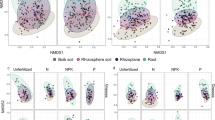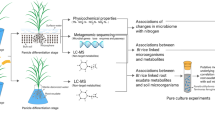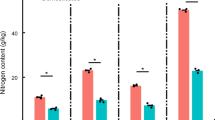Abstract
Nitrogen, one of the limiting factors for the yield of rice, can also have an important function in methane oxidation, thus affecting its global budget. Rice microcosms, planted in the greenhouse, were treated with the N-fertilizers urea (UPK) and ammonium sulfate (APK) or were only treated with phosphorous and potassium (PK). Methane oxidation rates in PK and UPK treatments were similar during most of the rice-growing season, revealing no effect of urea. However, ammonium sulfate strongly suppressed methanogenesis providing an unfavorable environment for methanotrophs in APK treatment. Roots and rhizospheric soil samples, collected from six different growth stages of the rice plant, were analyzed by terminal restriction fragment length polymorphism (T-RFLP) of the pmoA gene. Assignment of abundant T-RFs to cloned pmoA sequences indicated that the populations on roots were dominated by type-I methanotrophs, whereas the populations in rhizospheric soil were dominated by type-II methanotrophs irrespectively of growth stages and fertilizer treatments. Non-metric multidimensional scaling ordination analysis of T-RFLP profiles revealed that the methanotrophic community was significantly (P<0.001) affected by the different fertilizer treatments; however, the effect was stronger on the roots than in the rhizospheric soil. Contrary to pmoA gene-based analysis, pmoA transcript-based T-RFLP/cloning/sequencing analysis in rhizospheric soil showed type I as the predominant methanotrophs in both PK and UPK treatments. Collectively, our study showed that type-I methanotrophs were dominant and probably active in rhizospheric soil throughout the season irrespective of nitrogen fertilizer used, whereas type-II methanotrophs were relatively more dominant under unfavorable conditions, such as in APK treatment.
Similar content being viewed by others
Log in or create a free account to read this content
Gain free access to this article, as well as selected content from this journal and more on nature.com
or
Accession codes
References
Altschul SF, Gish W, Miller W, Myers EW, Lipman DJ . (1990). Basic local alignment search tool. J Mol Biol 215: 403–410.
Bodelier PLE, Hahn AP, Arth IR, Frenzel P . (2000a). Effects of ammonium-based fertilisation on microbial processes involved in methane emission from soils planted with rice. Biogeochemistry 51: 225–257.
Bodelier PLE, Roslev P, Henckel T, Frenzel P . (2000b). Stimulation by ammonium-based fertilizers of methane oxidation in soil around rice roots. Nature 403: 421–424.
Bosse U, Frenzel P, Conrad R . (1993). Inhibition of methane oxidation by ammonium in the surface-layer of a littoral sediment. FEMS Microbiol Ecol 13: 123–134.
Bourne DG, McDonald IR, Murrell JC . (2001). Comparison of pmoA PCR primer sets as tools for investigating methanotroph diversity in three Danish soils. Appl Environ Microbiol 67: 3802–3809.
Bowman J . (2006). The methanotrophs. The families Methylococcaceae and Methylocystaceae. In Dworkin M (ed). The Prokaryotes. Springer: New York, USA, 5: 266–289.
Bykova S, Boeckx P, Kravchenko I, Galchenko V, Van Cleemput O . (2007). Response of CH4 oxidation and methanotrophic diversity to NH4+ and CH4 mixing ratios. Biol Fertil Soils 43: 341–348.
Cai ZC, Xing GX, Yan XY, Xu H, Tsuruta H, Yagi K et al. (1997). Methane and nitrous oxide emissions from rice paddy fields as affected by nitrogen fertilisers and water management. Plant Soil 196: 7–14.
Cai ZC, Yan XY . (1999). Kinetic model for methane oxidation by paddy soil as affected by temperature, moisture and N addition. Soil Biol Biochem 31: 715–725.
Dan JG, Kruger M, Frenzel P, Conrad R . (2001). Effect of a late season urea fertilization on methane emission from a rice field in Italy. Agric Ecosyst Environ 83: 191–199.
Delgado JA, Mosier AR . (1996). Mitigation alternatives to decrease nitrous oxides emissions and urea-nitrogen loss and their effect on methane flux. J Environ Qual 25: 1105–1111.
Dunbar J, Ticknor LO, Kuske CR . (2001). Phylogenetic specificity and reproducibility and new method for analysis of terminal restriction fragment profiles of 16S rRNA genes from bacterial communities. Appl Environ Microbiol 67: 190–197.
Dunfield PF, Topp E, Archambault C, Knowles R . (1995). Effect of nitrogen fertilizers and moisture-content on Ch4 and N2o fluxes in a humisol—measurements in the field and intact soil cores. Biogeochemistry 29: 199–222.
Eller G, Frenzel P . (2001). Changes in activity and community structure of methane-oxidizing bacteria over the growth period of rice. Appl Environ Microbiol 67: 2395–2403.
Gilbert B, Frenzel P . (1995). Methanotrophic bacteria in the rhizosphere of rice microcosms and their effect on porewater methane concentration and methane emission. Biol Fertil Soils 20: 93–100.
Hanson RS, Hanson TE . (1996). Methanotrophic bacteria. Microbiol Rev 60: 439–471.
Henckel T, Roslev P, Conrad R . (2000). Effects of O-2 and CH4 on presence and activity of the indigenous methanotrophic community in rice field soil. Environ Microbiol 2: 666–679.
Hutsch BW, Webster CP, Powlson DS . (1994). Methane oxidation in soil as affected by land-use, soil-Ph and N-fertilization. Soil Biol Biochem 26: 1613–1622.
Ikenaga M, Asakawa S, Muraoka Y, Kimura M . (2003). Bacterial communities associated with nodal roots of rice plants along with the growth stages: estimation by PCR-DGGE and sequence analyses. Soil Sci Plant Nutr 49: 591–602.
Kolb S, Knief C, Stubner S, Conrad R . (2003). Quantitative detection of methanotrophs in soil by novel pmoA-targeted real-time PCR assays. Appl Environ Microbiol 69: 2423–2429.
Kruger M, Eller G, Conrad R, Frenzel P . (2002). Seasonal variation in pathways of CH4 production and in CH4 oxidation in rice fields determined by stable carbon isotopes and specific inhibitors. Glob Change Biol 8: 265–280.
Kruger M, Frenzel P . (2003). Effects of N-fertilisation on CH4 oxidation and production, and consequences for CH4 emissions from microcosms and rice fields. Glob Change Biol 9: 773–784.
Kruger M, Frenzel P, Conrad R . (2001). Microbial processes influencing methane emission from rice fields. Glob Change Biol 7: 49–63.
Ludwig W, Strunk O, Westram R, Richter L, Meier H, Yadhukumar et al. (2004). ARB: a software environment for sequence data. Nucleic Acids Res 32: 1363–1371.
Minamikawa K, Sakai N, Hayashi H . (2005). The effects of ammonium sulfate application on methane emission and soil carbon content of a paddy field in Japan. Agric Ecosyst Environ 107: 371–379.
Neue HU, Wassmann R, Kludze HK, Bujun W, Lantin RS . (1997). Factors and processes controlling methane emissions from rice fields. Nutrient Cycling Agroecosyst 49: 111–117.
Noll M, Frenzel P, Conrad R . (2008). Selective stimulation of type I methanotrophs in a rice paddy soil by urea fertilization revealed by RNA-based stable isotope probing. FEMS Microbiol Ecol 65: 125–132.
Oksanen J . (2008). Multivariate analysis of ecological communities in R: vegan tutorial. [WWW document]. URL http://cc.oulu.fi/∼jarioksa/opetus/metodi/vegantutor.pdf 2-13-2008. Ref Type: Internet Communication.
Qiu QF, Noll M, Abraham WR, Lu YH, Conrad R . (2008). Applying stable isotope probing of phospholipid fatty acids and rRNA in a Chinese rice field to study activity and composition of the methanotrophic bacterial communities in situ. ISME J 2: 602–614.
Schimel J . (2000). Global change—rice, microbes and methane. Nature 403: 375–377.
Shrestha M, Abraham WR, Shrestha PM, Noll M, Conrad R . (2008). Activity and composition of methanotrophic bacterial communities in planted rice soil studied by flux measurements, analyses of pmoA gene and stable isotope probing of phospholipid fatty acids. Environ Microbiol 10: 400–412.
Shrestha PM, Kube M, Reinhardt R, Liesack W . (2009). Transcriptional activity of paddy soil bacterial communities. Environ Microbiol 11: 960–970.
Steudler PA, Bowden RD, Melillo JM, Aber JD . (1989). Influence of nitrogen-fertilization on methane uptake in temperate forest soils. Nature 341: 314–316.
Wickham H . (2007). Reshaping data with the reshape package. J Stat Softw 21: 1–20.
Acknowledgements
We thank Elisabetta Lupotto and the C.R.A. Unità di Ricerca per la Risicoltura for support at the rice fields in Vercelli, Italy. This study was financially supported by grants from the Fonds der Chemischen Industrie to RC and by the Deutsche Forschungsgemeinschaft (ESF and EuroDIVERSITY-METHECO) to PF.
Author information
Authors and Affiliations
Corresponding author
Additional information
Supplementary Information accompanies the paper on The ISME Journal website
Supplementary information
Rights and permissions
About this article
Cite this article
Shrestha, M., Shrestha, P., Frenzel, P. et al. Effect of nitrogen fertilization on methane oxidation, abundance, community structure, and gene expression of methanotrophs in the rice rhizosphere. ISME J 4, 1545–1556 (2010). https://doi.org/10.1038/ismej.2010.89
Received:
Revised:
Accepted:
Published:
Issue date:
DOI: https://doi.org/10.1038/ismej.2010.89
Keywords
This article is cited by
-
Effects of different nitrogen applications and straw return depth on straw microbial and carbon and nitrogen cycles in paddy fields in the cool zone
Scientific Reports (2024)
-
Type I methanotrophs dominated methane oxidation and assimilation in rice paddy fields by the consequence of niche differentiation
Biology and Fertility of Soils (2024)
-
Greenhouse gas emissions and mitigation in rice agriculture
Nature Reviews Earth & Environment (2023)
-
Responses of soil carbon cycling microbial functional genes to nitrogen and phosphorus addition in saline-sodic soils
Plant and Soil (2023)
-
Methane emission from rice cultivation regulated by soil hydrothermal condition and available carbon and nitrogen under a rice–wheat rotation system
Plant and Soil (2022)



